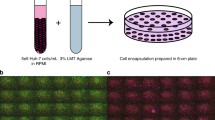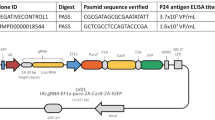Abstract
Background and purpose
The electric field and the concomitant heat (electrohyperthermia) can synergistically induce cell death in tumor tissue, due to elevated glycolysis, ion concentration, and permittivity in malignant compared with nonmalignant tissues. Here we studied the mechanism and time course of tumor destruction caused by electrohyperthermia.
Material and methods
Bilateral implants of HT29 colorectal cancer in the femoral regions of Balb/c (nu/nu) mice were treated with a single 30-min shot of modulated, 13.56-MHz, radiofrequency-generated electrohyperthermia (mEHT). Tumors at 0, 1, 4, 8, 14, 24, 48, and 72 h posttreatment were studied for morphology, DNA fragmentation, and cell death response-related protein expression using tissue microarrays, immunohistochemistry, Western immunoblots, and terminal deoxynucleotidyl transferase dUTP nick end labeling (TUNEL) assays.
Results
Modulated EHT treatment induced significant tumor destruction in HT29 xenografts with a peak of a sevenfold increase compared with the untreated controls. The significant treatment-related elevation of DNA fragmentation—detected with TUNEL assay—and apoptotic bodies between 24 and 72 h posttreatment was proof of a programmed cell death response. This was associated with significant mitochondrial accumulation of bax and mitochondrial-to-cytoplasmic release of cytochrome c proteins between 8 and 14 h. Cleaved caspase-3 levels were low and mainly localized to inflammatory cells. The substantial cytoplasmic-to-nuclear translocation of apoptosis-inducing factor (AIF) and its 57-kDa activated fragment detected between 14 and 24 h after treatment indicated AIF as an effector for DNA fragmentation.
Conclusion
Modulated EHT treatment can induce programmed cell death-related tumor destruction in HT29 colorectal adenocarcinoma xenografts, which dominantly follows a caspase-independent subroutine.
Zusammenfassung
Hintergrund und Ziel
Die gleichzeitige Einwirkung elektrischer Felder und Hitze (Elektrohyperthermie) kann durch eine im Vergleich zu gesunden Zellen erhöhte Glykolyse, Ionenkonzentration und elektrische Leitfähigkeit in Tumorgewebe synergistisch zum Zelltod führen. Diese Arbeit untersucht den Mechanismus und den Zeitverlauf der durch Elektrohyperthermie induzierten Tumorzerstörung.
Material und Methoden
Bilaterale Implantate von HT29-Kolorektalkrebszellen im Oberschenkelbereich von Balb/c-(nu/nu-)-Mäusen wurden 30 min lang einer durch eine modulierte Radiofrequenz von 13,56 MHz erzeugten Elektrohyperthermie (mEHT) ausgesetzt. Jeweils 0, 1, 4, 8, 14, 24, 48 und 72 h nach Behandlung wurden die Tumore hinsichtlich Morphologie, DNA-Fragmentierung und Zelltodantwort auf Proteinexpressionsebene untersucht, wobei Gewebe-Mikroarrays, immunhistochemische Methoden, Western-Blots und TUNEL-Assays ("Terminal Deoxynucleotidyl Transferase dUTP Nick End Labeling") eingesetzt wurden.
Ergebnisse
Die mEHT-Behandlung führte in HT29-Xenografts zu einer signifikanten Zerstörung von Tumorgewebe vom bis zum 7-Fachen der unbehandelten Kontrollen. Die signifikante behandlungsinduzierte DNA-Fragmentierung (Detektion durch TUNEL-Assay) und Bildung von Apoptosekörpern 24–72 h nach Behandlung ließ erkennen, dass es zum programmierten Zelltod gekommen war. Daneben wurde nach 8–14 h eine signifikante Akkumulation von Bax in den Mitochondrien und eine Freisetzung von mitochondrialem Cytochrom c in das Zellplasma beobachtet. Die Konzentration an gespaltener Caspase-3 war niedrig und im Wesentlichen auf Entzündungszellen beschränkt. Die 14–24 h nach Behandlung festgestellte umfangreiche Translokation von zytoplasmatischem apoptoseinduzierendem Faktor (AIF) und seinem aktiven 57-kDa-Fragment in den Kern deutete auf AIF als Auslöser für die DNA-Fragmentierung hin.
Schlussfolgerung
Die mEHT-Behandlung kann in kolorektalen HT29-Adenokarzinom-Xenografts Tumorgewebe durch Induktion des programmierten Zelltods zerstören, wobei hauptsächlich ein caspaseunabhängiger Pfad beschritten wird.






Similar content being viewed by others
References
Andocs G et al (2009) Strong synergy of heat and modulated electromagnetic field in tumor cell killing. Strahlenther Onkol 185:120–126
Andocs G, Szasz O, Szasz A (2009) Oncothermia treatment of cancer: from the laboratory to clinic. Electromagn Biol Med 28:148–165
Baritaud M et al (2010) Histone H2AX: the missing link in AIF-mediated caspase-independent programmed necrosis. Cell Cycle 9:3166–3173
Bayley JP, Devilee P (2012) The Warburg effect in 2012. Curr Opin Oncol 24:62–67
Blad B, Baldetorp B (1996) Impedance spectra of tumour tissue in comparison with normal tissue; a possible clinical application for electrical impedance tomography. Physiol Meas 17:A105–A115
Blad B et al (1999) An electrical impedance index to distinguish between normal and cancerous tissues. J Med Eng Technol 23:57–62
Boujrad H et al (2007) AIF-mediated programmed necrosis: a highly regulated way to die. Cell Cycle 6:2612–2619
Elmore S (2007) Apoptosis: a review of programmed cell death. Toxicol Pathol 35:495–516
Fiorentini G et al (2006) A phase II clinical study on relapsed malignant gliomas treated with electro-hyperthermia. In Vivo 20:721–724
Fiorentini G, Szasz A (2006) Hyperthermia today: electric energy, a new opportunity in cancer treatment. J Cancer Res Ther 2:41–46
Foster KR (1999) Dielectric properties of tissues. In: Bronzino JD (ed) The biomedical engeneering handbook, 2nd edn. CRC Press, Boca Raton
Frey B et al (2012) Old and new facts about hyperthermia-induced modulations of the immune system. Int J Hyperthermia 28:528–542
Galluzzi L et al (2012) Molecular definitions of cell death subroutines: recommendations of the Nomenclature Committee on Cell Death 2012. Cell Death Differ 19:107–120
Garczarczyk D et al (2010) Protein kinase Cgamma in colon cancer cells: expression, Thr514 phosphorylation and sensitivity to butyrate-mediated upregulation as related to the degree of differentiation. Chem Biol Interact 185:25–32
Goetze K et al (2013) Glycolysis-related gene induction and ATP reduction during fractionated irradiation: Markers for radiation responsiveness of human tumor xenografts. Strahlenther Onkol (in press)
Gogvadze V, Orrenius S, Zhivotovsky B (2006) Multiple pathways of cytochrome c release from mitochondria in apoptosis. Biochim Biophys Acta 1757:639–647
Hager ED et al (1999) Deep hyperthermia with radiofrequencies in patients with liver metastases from colorectal cancer. Anticancer Res 19:3403–3408
Harmon BV et al (1990) Cell death induced in a murine mastocytoma by 42–47 degrees C heating in vitro: evidence that the form of death changes from apoptosis to necrosis above a critical heat load. Int J Radiat Biol 58:845–858
Hildebrandt B et al (2002) The cellular and molecular basis of hyperthermia. Crit Rev Oncol Hematol 43:33–56
Hojka-Osinska A, Ziolo E, Rapak A (2012) Combined treatment with fenretinide and indomethacin induces AIF-mediated, non-classical cell death in human acute T-cell leukemia Jurkat cells. Biochem Biophys Res Commun 419:590–595
Kampinga HH (2006) Cell biological effects of hyperthermia alone or combined with radiation or drugs: a short introduction to newcomers in the field. Int J Hyperthermia 22:191–196
Kroemer G, Martin SJ (2005) Caspase-independent cell death. Nat Med 11:725–730
Lovey J et al (2008) Recombinant human erythropoietin alpha improves the efficacy of radiotherapy of a human tumor xenograft, affecting tumor cells and microvessels. Strahlenther Onkol 184:1–7
Mantel F et al (2010) Combination of ionising irradiation and hyperthermia activates programmed apoptotic and necrotic cell death pathways in human colorectal carcinoma cells. Strahlenther Onkol 186:587–599
Mirkes PE (2008) Cell death in normal and abnormal development. Congenit Anom (Kyoto) 48:7–17
Natarajan SK, Becker DF (2012) Role of apoptosis-inducing factor, proline dehydrogenase, and NADPH oxidase in apoptosis and oxidative stress. Cell Health Cytoskelet 2012:11–27
Norberg E, Orrenius S, Zhivotovsky B (2010) Mitochondrial regulation of cell death: processing of apoptosis-inducing factor (AIF). Biochem Biophys Res Commun 396:95–100
Pethig R et al (1984) Interaction of the 2,6-dimethoxysemiquinone and ascorbyl free radicals with Ehrlich ascites cells: a probe of cell-surface charge. Proc Natl Acad Sci USA 81:2088–2091
Rong Y, Mack P (2000) Apoptosis induced by hyperthermia in Dunn osteosarcoma cell line in vitro. Int J Hyperthermia 16:19–27
Shchepotin IB et al (1997) Apoptosis induced by hyperthermia and verapamil in vitro in a human colon cancer cell line. Int J Hyperthermia 13:547–557
Shrivastava A et al (2006) Molecular iodine induces caspase-independent apoptosis in human breast carcinoma cells involving the mitochondria-mediated pathway. J Biol Chem 281:19762–19771
Tait SW, Green DR (2010) Mitochondria and cell death: outer membrane permeabilization and beyond. Nat Rev Mol Cell Biol 11:621–632
Tamamoto T et al (2003) Heat-induced growth inhibition and apoptosis in transplanted human head and neck squamous cell carcinomas with different status of p53. Int J Hyperthermia 19:590–597
Tischner D et al (2012) Necrosis-like death can engage multiple pro-apoptotic Bcl-2 protein family members. Apoptosis 17:1197–1209
Warburg O (1956) On the origin of cancer cells. Science 123:309–314
Wismeth C et al (2010) Transcranial electro-hyperthermia combined with alkylating chemotherapy in patients with relapsed high-grade gliomas: phase I clinical results. J Neurooncol 98:395–405
Yonezawa M et al (1996) Hyperthermia induces apoptosis in malignant fibrous histiocytoma cells in vitro. Int J Cancer 66:347–351
Zou Y, Guo Z (2003) A review of electrical impedance techniques for breast cancer detection. Med Eng Phys 25:79–90
Acknowledgments
The authors are grateful to Edit Parsch, Renata Papp, Marcell A. Szasz, Agoston Ghidan, Diana Brauswetter, and Sandor Kiss for their technical assistance. This work was supported by grants KMOP-1.1.4-07/1-2008-0083, KMOP 1.1.1-08/1-2008-0059, and TÉT-10-1-2011-0914 in Hungary.
Compliance with ethical guidelines
Conflict of interest
N. Meggyeshazi, G. Andocs, L. Balogh, P. Balla, G. Kiszner, I. Teleki, A. Jeney, and T. Krenacs state that there are no conflicts of interest. All national guidelines on the care and use of laboratory animals have been followed and the necessary approval was obtained from the relevant authorities.
Author information
Authors and Affiliations
Corresponding author
Rights and permissions
About this article
Cite this article
Meggyeshazi, N., Andocs, G., Balogh, L. et al. DNA fragmentation and caspase-independent programmed cell death by modulated electrohyperthermia. Strahlenther Onkol 190, 815–822 (2014). https://doi.org/10.1007/s00066-014-0617-1
Received:
Accepted:
Published:
Issue Date:
DOI: https://doi.org/10.1007/s00066-014-0617-1
Keywords
- Modulated electrohyperthermia
- Colorectal cancer xenograft
- Programmed tumor cell death
- Caspase-independent cell death
- DNA fragmentation




